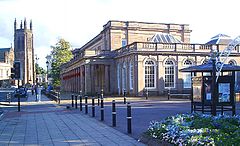Royal Leamington Spa
|
Royal Leamington Spa Leamington Spa |
||
|---|---|---|
| The pump house opened in 1814 | ||
| Coordinates | 52 ° 17 ′ N , 1 ° 32 ′ W | |
|
|
||
| Residents | 42,304 | |
| administration | ||
| Post town | LEAMINGTON SPA | |
| ZIP code section | CV31, CV32, CV33 | |
| prefix | 01926 | |
| Part of the country | England | |
| region | West Midlands | |
| Shire county | Warwickshire | |
| District | Warwick | |
| ONS code | SP316660 | |
| British Parliament | Warwick and Leamington | |
Royal Leamington Spa , commonly Leamington Spa or Leamington [ ˈlɛmɪŋtən ] for short, is a spa town in the center of Warwickshire , England . Leamington Spa has 42,304 residents (as of 2001) and is named after the Leam River that flows through the city. Leamington Spa is the administrative headquarters of District Warwick .
Leamington is the most popular town in the southern half of Warwickshire (which is almost split in two by Coventry , which is part of the new West Midlands ) and offers better shopping than other towns of the same size. The city is growing rapidly, especially towards the south. Many residents commute from Leamington to Coventry (10 miles north) and Birmingham (25 miles northwest).
Many students and employees of the University of Warwick at Coventry live in Leamington; the city therefore has a strong nightlife with a large number of restaurants and bars, from cheap to extravagant.
Leamington is a thriving city of Georgian and early Victorian architecture . The numerous Georgian townhouses in particular give Leamington an important appearance. As a result of the growing population, the city now borders on the neighboring city of Warwick . Some residents colloquially call the city Leam .
history
Leamington is a comparatively young city. Until the beginning of the 19th century, the place was little more than a village. At the turn of the century, balneology took off and Leamington boasted a suitable healing spring.
In 1814, the Royal Pump Rooms and Baths opened, near the Leam River that flows through the city. This wonderful location attracted many visitors who hoped for relief from their various ailments and pains by bathing in the pools filled with brine . Leamington quickly became a popular health resort, attracting the rich and famous; as a result, numerous Georgian style townhouses were built to accommodate visitors.
Leamington's reputation spread quickly. After a visit by Queen Victoria , whose statue is still in Leamington today, the city name was given the addition Royal in 1838 .
The use of the pump rooms changed over the years. From around the end of World War II until 1996, they were used for medical applications. In 1996 the city administration closed the facility and converted the building into a cultural center. Here there is an art gallery (Leamington Art Gallery), a museum, a library as well as the tourist information and a café.
In the middle of the 19th century, health resorts went out of fashion. Even so, Leamington remained a favorite with retirees and wealthy residents who moved here from Coventry and Birmingham. Leamington became a popular place for shopping because of its wealthy population.
By 1901 the population of Leamington had grown to nearly 27,000. During the 20th century, the population continued to grow to over 42,000.
In 1983 the city was awarded the European Prize awarded for their outstanding efforts to European integration thoughts.
Neighboring places
- Warwick : 1.5 km west
- Whitnash : 1.5 km south
- Cubbington : 1.5 km northeast
- Stratford-upon-Avon : 10 miles southwest
- Kenilworth : 10 km north
- Rugby : 23 km northeast
- Birmingham : 40 km northwest.
Town twinning
there are also friendships with:
- Leamington, Ontario , Canada
- Bo , Sierra Leone
sons and daughters of the town
- Ernest Belfort Bax (1854–1926), socialist journalist and philosopher
- Edward Leamington Nichols (1854-1937), physicist
- Aleister Crowley (1875–1947), occultist, mystic, poet, artist, artist-manager and social critic
- Benjamin Anthony Foster (born 1983), football player
- Terry Frost (1915-2003), artist
- Hilary Griffiths (* 1949), conductor, including Kapellmeister of the Cologne Opera
- John Richard Hicks (1904–1989), economist
- David Hobbs (* 1939), racing car driver
- Christian Horner (* 1973), automobile racing driver
- William Lyons (1901–1985), automobile manufacturer and founder of Jaguar Cars
- Wilfrid Mellers (1914–2008), music critic, musicologist, music teacher and composer
- Leila Mimmack (* 1993), actress
- Rosa Newmarch (1857–1940), music writer
- Jack Payne (1899–1969), orchestra conductor and television presenter
- Ernest Renshaw (1861-1899), tennis player
- William Renshaw (1861-1904), tennis player
- Robert Simpson (1921–1997), composer
- Bernard Spilsbury (1877–1947), pathologist and forensic scientist
- Henry Tandey (1891–1977), recipient of the Victoria Cross, most highly decorated British private of the First World War
Web links
Individual evidence
- ↑ Who is who? The German who's who. Founded by Walter Habel. Federal Republic of Germany and West Berlin. 24th edition. Schmidt-Römhild, Lübeck 1985, ISBN 3-7950-2005-0 , p. 407.



